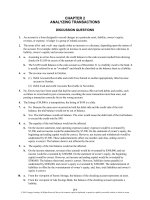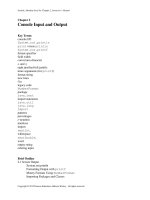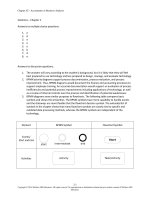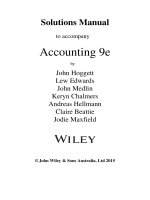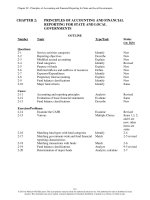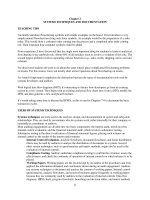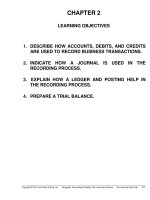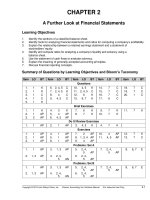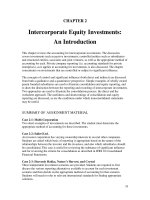Test bank and solution of analyzing transactions (2)
Bạn đang xem bản rút gọn của tài liệu. Xem và tải ngay bản đầy đủ của tài liệu tại đây (381.04 KB, 70 trang )
CHAPTER 2
ANALYZING TRANSACTIONS
DISCUSSION QUESTIONS
1.
An account is a form designed to record changes in a particular asset, liability, owner’s equity,
revenue, or expense. A ledger is a group of related accounts.
2.
The terms debit and credit may signify either an increase or a decrease, depending upon the nature of
the account. For example, debits signify an increase in asset and expense accounts but a decrease in
liability, owner’s capital, and revenue accounts.
3.
a.
Assuming no errors have occurred, the credit balance in the cash account resulted from drawing
checks for $1,850 in excess of the amount of cash on deposit.
b.
The $1,850 credit balance in the cash account as of December 31 is a liability owed to the bank. It
is usually referred to as an “overdraft” and should be classified on the balance sheet as a liability.
a.
The revenue was earned in October.
b.
(1) Debit Accounts Receivable and credit Fees Earned or another appropriately titled revenue
account in October.
4.
(2) Debit Cash and credit Accounts Receivable in November.
5.
No. Errors may have been made that had the same erroneous effect on both debits and credits, such
as failure to record and/or post a transaction, recording the same transaction more than once, and
posting a transaction correctly but to the wrong account.
6.
The listing of $9,800 is a transposition; the listing of $100 is a slide.
7.
a.
No. Because the same error occurred on both the debit side and the credit side of the trial
balance, the trial balance would not be out of balance.
b.
Yes. The trial balance would not balance. The error would cause the debit total of the trial balance
to exceed the credit total by $90.
a.
The equality of the trial balance would not be affected.
b.
On the income statement, total operating expenses (salary expense) would be overstated by
$7,500, and net income would be understated by $7,500. On the statement of owner’s equity, the
beginning and ending capital would be correct. However, net income and withdrawals would be
understated by $7,500. These understatements offset one another, and, thus, ending owner’s
equity is correct. The balance sheet is not affected by the error.
a.
The equality of the trial balance would not be affected.
b.
On the income statement, revenues (fees earned) would be overstated by $300,000, and net
income would be overstated by $300,000. On the statement of owner’s equity, the beginning
capital would be correct. However, net income and ending capital would be overstated by
$300,000. The balance sheet total assets is correct. However, liabilities (notes payable) is
understated by $300,000, and owner’s equity is overstated by $300,000. The understatement of
liabilities is offset by the overstatement of owner’s equity, and, thus, total liabilities and owner’s
equity is correct.
a.
From the viewpoint of Surety Storage, the balance of the checking account represents an asset.
b.
From the viewpoint of Ada Savings Bank, the balance of the checking account represents a
liability.
8.
9.
10.
2-1
© 2014 Cengage Learning. All Rights Reserved. May not be scanned, copied or duplicated, or posted to a publicly accessible website, in whole or in part.
CHAPTER 2
Analyzing Transactions
PRACTICE EXERCISES
PE 2–1A
1.
2.
3.
4.
5.
6.
Debit and credit entries, normal debit balance
Credit entries only, normal credit balance
Debit and credit entries, normal credit balance
Credit entries only, normal credit balance
Credit entries only, normal credit balance
Debit entries only, normal debit balance
PE 2–1B
1.
2.
3.
4.
5.
6.
Debit and credit entries, normal credit balance
Debit and credit entries, normal debit balance
Debit entries only, normal debit balance
Debit entries only, normal debit balance
Debit entries only, normal debit balance
Credit entries only, normal credit balance
PE 2–2A
Feb.
12 Office Equipment
Cash
Accounts Payable
18,000
30 Office Supplies
Cash
Accounts Payable
2,500
7,000
11,000
PE 2–2B
Sept.
800
1,700
2-2
© 2014 Cengage Learning. All Rights Reserved. May not be scanned, copied or duplicated, or posted to a publicly accessible website, in whole or in part.
CHAPTER 2
Analyzing Transactions
PE 2–3A
July
9 Accounts Receivable
Fees Earned
12,000
12,000
PE 2–3B
Aug.
13 Cash
Fees Earned
9,000
9,000
PE 2–4A
Jan.
25 Jay Nolan, Drawing
Cash
16,000
16,000
PE 2–4B
June
30 Dawn Pierce, Drawing
Cash
11,500
11,500
PE 2–5A
Using the following T account, solve for the amount of cash receipts (indicated
by ? below).
Cash
Feb. 1 Bal.
Cash receipts
Feb. 28 Bal.
14,750
93,400
Cash payments
?
15,200
$15,200 = $14,750 + Cash receipts – $93,400
Cash receipts = $15,200 + $93,400 – $14,750 = $93,850
PE 2–5B
Using the following T account, solve for the amount of supplies expense
(indicated by ? below).
Supplies
Aug. 1 Bal.
1,025
Supplies purchased
3,110
Aug. 31 Bal.
1,324
?
Supplies expense
$1,324 = $1,025 + $3,110 – Supplies expense
Supplies expense = $1,025 + $3,110 – $1,324 = $2,811
2-3
© 2014 Cengage Learning. All Rights Reserved. May not be scanned, copied or duplicated, or posted to a publicly accessible website, in whole or in part.
CHAPTER 2
Analyzing Transactions
PE 2–6A
a.
The totals are unequal. The credit total is lower by $900 ($5,400 – $4,500).
b.
The totals are equal since both the debit and credit entries were journalized
and posted for $720.
c.
The totals are unequal. The debit total is higher by $3,200 ($1,600 + $1,600).
PE 2–6B
a.
The totals are equal since both the debit and credit entries were journalized
and posted for $12,900.
b.
The totals are unequal. The credit total is higher by $1,656 ($1,840 – $184).
c.
The totals are unequal. The debit total is higher by $4,500 ($8,300 – $3,800).
PE 2–7A
a.
Utilities Expense
Miscellaneous Expense
7,300
Utilities Expense
Cash
7,300
7,300
7,300
Note: The first entry in (a) reverses the incorrect entry, and the second entry
records the correct entry. These two entries could also be combined into one
entry as shown below; however, preparing two entries would make it easier
for someone to understand later what happened and why the entries were
necessary.
Utilities Expense
Miscellaneous Expense
Cash
b.
14,600
7,300
7,300
Accounts Payable
Accounts Receivable
6,100
6,100
2-4
© 2014 Cengage Learning. All Rights Reserved. May not be scanned, copied or duplicated, or posted to a publicly accessible website, in whole or in part.
CHAPTER 2
Analyzing Transactions
PE 2–7B
a.
b.
Cash
Accounts Receivable
8,400
Supplies
Office Equipment
2,500
Supplies
Accounts Payable
2,500
8,400
2,500
2,500
Note: The first entry in (b) reverses the incorrect entry, and the second entry
records the correct entry. These two entries could also be combined into one
entry as shown below; however, preparing two entries would make it easier
for someone to understand later what happened and why the entries were
necessary.
Supplies
Office Equipment
Accounts Payable
5,000
2,500
2,500
PE 2–8A
Fuller Company
Income Statements
For Years Ended December 31
Increase/(Decrease)
Fees earned
Operating expenses
Net income
2014
2013
Amount
$680,000
541,875
$138,125
$850,000
637,500
$212,500
$(170,000)
(95,625)
$ (74,375)
Percent
–20.0%
–15.0%
–35.0%
PE 2–8B
Paragon Company
Income Statements
For Years Ended December 31
Increase/(Decrease)
2014
Fees earned
Operating expenses
Net income
$1,416,000
1,044,000
$ 372,000
2013
$1,200,000
900,000
$ 300,000
Amount
$216,000
144,000
$ 72,000
Percent
18.0%
16.0%
24.0%
2-5
© 2014 Cengage Learning. All Rights Reserved. May not be scanned, copied or duplicated, or posted to a publicly accessible website, in whole or in part.
CHAPTER 2
Analyzing Transactions
EXERCISES
Ex. 2–1
Balance Sheet Accounts
Income Statement Accounts
Assets
Revenue
Cargo and Mail Revenue
Passenger Revenue
Flight Equipment
Purchase Deposits for Flight Equipmenta
Spare Parts and Supplies
Expenses
Aircraft Fuel Expense
Commissions (Expense)c
Landing Fees (Expense)d
Liabilities
Accounts Payable
Air Traffic Liabilityb
Owner’s Equity
None
a
Advance payments (deposits) on aircraft to be delivered in the future
Passenger ticket sales not yet recognized as revenue
c
Commissions paid to travel agents
d
Fees paid to airports for landing rights
b
Ex. 2–2
Account
Account
Number
Accounts Payable
Accounts Receivable
Cash
Fees Earned
Gina Kissel, Capital
Gina Kissel, Drawing
Land
Miscellaneous Expense
Supplies Expense
Wages Expense
21
12
11
41
31
32
13
53
52
51
Note: Expense accounts are normally listed in order of magnitude from largest to
smallest with Miscellaneous Expense always listed last. Since Wages Expense is
normally larger than Supplies Expense, Wages Expense is listed as account
number 51 and Supplies Expense as account number 52.
2-6
© 2014 Cengage Learning. All Rights Reserved. May not be scanned, copied or duplicated, or posted to a publicly accessible website, in whole or in part.
CHAPTER 2
Analyzing Transactions
Ex. 2–3
Balance Sheet Accounts
Income Statement Accounts
1. Assets
11
12
13
14
15
4. Revenue
41 Fees Earned
Cash
Accounts Receivable
Supplies
Prepaid Insurance
Equipment
51
52
53
59
2. Liabilities
21 Accounts Payable
22 Unearned Rent
5. Expenses
Wages Expense
Rent Expense
Supplies Expense
Miscellaneous Expense
3. Owner’s Equity
31 Ivy Bishop, Capital
32 Ivy Bishop, Drawing
Note: The order of some of the accounts within the major classifications is
somewhat arbitrary, as in accounts 13–14, accounts 21–22, and accounts 51–53.
In a new business, the order of magnitude of balances in such accounts is not
determinable in advance. The magnitude may also vary from period to period.
Ex. 2–4
a.
b.
c.
d.
e.
f.
debit
credit
credit
credit
debit
credit
g.
h.
i.
j.
k.
l.
debit
credit
debit
credit
debit
debit
Ex. 2–5
1.
debit and credit entries (c)
2.
debit and credit entries (c)
3.
debit and credit entries (c)
4.
credit entries only (b)
5.
debit entries only (a)
6.
debit entries only (a)
7.
debit entries only (a)
2-7
© 2014 Cengage Learning. All Rights Reserved. May not be scanned, copied or duplicated, or posted to a publicly accessible website, in whole or in part.
CHAPTER 2
Analyzing Transactions
Ex. 2–6
a.
b.
c.
d.
Liability—credit
Asset—debit
Owner’s equity
(Amanda Whitmore, Capital)—credit
Owner’s equity
(Amanda Whitmore, Drawing)—debit
e.
f.
g.
h.
i.
j.
Asset—debit
Revenue—credit
Asset—debit
Expense—debit
Asset—debit
Expense—debit
Ex. 2–7
2014
July
1 Rent Expense
Cash
3,200
3,200
3 Advertising Expense
Cash
750
750
5 Supplies
Cash
1,300
1,300
6 Office Equipment
Accounts Payable
12,500
12,500
10 Cash
Accounts Receivable
11,400
11,400
15 Accounts Payable
Cash
1,175
1,175
27 Miscellaneous Expense
Cash
600
30 Utilities Expense
Cash
180
600
180
31 Accounts Receivable
Fees Earned
33,760
33,760
31 Utilities Expense
Cash
1,300
31 Dennis Isberg, Drawing
Cash
4,000
1,300
4,000
2-8
© 2014 Cengage Learning. All Rights Reserved. May not be scanned, copied or duplicated, or posted to a publicly accessible website, in whole or in part.
CHAPTER 2
Analyzing Transactions
Ex. 2–8
a.
JOURNAL
2014
May
Post.
Ref.
Description
Date
19
Page
Adjusting Entries
22 Supplies
Accounts Payable
Purchased supplies on account.
15
21
Debit
Credit
6,180
6,180
b., c., d.
Account:
Supplies
Post.
Date
2014
May
Account:
Item
1 Balance
22
Ref.
9
19
Balance
Debit
Credit
Debit
6,180
2014
May
e.
1 Balance
22
21
Account No.
Post.
Item
Credit
1,500
7,680
Accounts Payable
Date
15
Account No.
Ref.
Balance
Debit
9
19
Credit
Debit
Credit
16,750
22,930
6,180
Yes, the rules of debit and credit apply to all companies.
Ex. 2–9
a. (1)
(2)
(3)
(4)
Accounts Receivable
Fees Earned
48,600
Supplies
Accounts Payable
1,975
48,600
1,975
Cash
Accounts Receivable
31,400
31,400
Accounts Payable
Cash
1,350
1,350
2-9
© 2014 Cengage Learning. All Rights Reserved. May not be scanned, copied or duplicated, or posted to a publicly accessible website, in whole or in part.
CHAPTER 2
Analyzing Transactions
Ex. 2–9 (Concluded)
b.
(3)
Cash
31,400
(4)
(2)
Supplies
1,975
Accounts Receivable
48,600
(3)
(1)
c.
1,350
(4)
Accounts Payable
1,350 (2)
1,975
Fees Earned
(1)
48,600
31,400
No. A credit balance in Accounts Receivable could occur if a customer
overpaid his or her account. Regardless, the credit balance should be
investigated to verify that an error has not occurred.
Ex. 2–10
a.
The increase of $140,000 ($515,000 – $375,000) in the cash account does not
indicate net income of that amount. Net income is the net change in all assets
and liabilities from operating (revenue and expense) transactions.
b.
$60,000 ($200,000 – $140,000)
or
Cash
X
515,000
200,000
375,000
X + $515,000 – $375,000 = $200,000
X = $200,000 – $515,000 + $375,000
X = $60,000
2-10
© 2014 Cengage Learning. All Rights Reserved. May not be scanned, copied or duplicated, or posted to a publicly accessible website, in whole or in part.
CHAPTER 2
Analyzing Transactions
Ex. 2–11
Accounts Payable
Mar.
1
276,500
Mar. 31
a.
X
261,000
76,000
X + $261,000 – $276,500 = $76,000
X = $76,000 + $276,500 – $261,000
X = $91,500
b.
July
1
July
31
Accounts Receivable
49,000
X
61,500
525,000
$49,000 + X – $525,000 = $61,500
X = $61,500 + $525,000 – $49,000
X = $537,500
c.
Sept.
1
Sept.
30
Cash
28,440
112,100
33,200
X
$28,440 + $112,100 – X = $33,200
X = $28,440 + $112,100 – $33,200
X = $107,340
Ex. 2–12
a.
Debit (negative) balance of $16,000 ($314,000 – $10,000 – $320,000). This
negative balance means that the liabilities of Waters' business exceed the
assets.
b.
Yes. The balance sheet prepared at December 31 will balance, with Terrace
Waters, Capital, being reported in the owner’s equity section as a negative
$16,000.
2-11
© 2014 Cengage Learning. All Rights Reserved. May not be scanned, copied or duplicated, or posted to a publicly accessible website, in whole or in part.
CHAPTER 2
Analyzing Transactions
Ex. 2–13
a. and b.
Account Debited
Transaction
Type
Account Credited
Effect
Type
Effect
owner’s equity
asset
asset
liability
asset
revenue
asset
asset
asset
asset
+
–
–
+
–
+
–
–
–
–
(1)
(2)
(3)
asset
asset
asset
+
+
+
(4)
(5)
(6)
(7)
(8)
(9)
expense
asset
liability
asset
expense
drawing
+
+
–
+
+
+
Ex. 2–14
(1) Cash
Luis Chavez, Capital
75,000
75,000
(2) Supplies
Cash
4,000
4,000
(3) Equipment
Accounts Payable
Cash
25,000
(4) Operating Expenses
Cash
2,700
(5) Accounts Receivable
Service Revenue
19,500
22,000
3,000
2,700
19,500
(6) Accounts Payable
Cash
9,000
9,000
(7) Cash
Accounts Receivable
11,000
11,000
(8) Operating Expenses
Supplies
2,000
(9) Luis Chavez, Drawing
Cash
5,000
2,000
5,000
2-12
© 2014 Cengage Learning. All Rights Reserved. May not be scanned, copied or duplicated, or posted to a publicly accessible website, in whole or in part.
CHAPTER 2
Analyzing Transactions
Ex. 2–15
a.
GRAND CANYON TOURS CO.
Unadjusted Trial Balance
April 30, 2014
Debit
Balances
Cash
Accounts Receivable
Supplies
Equipment
Accounts Payable
Luis Chavez, Capital
Luis Chavez, Drawing
Service Revenue
Operating Expenses
b.
Credit
Balances
62,300
8,500
2,000
25,000
13,000
75,000
5,000
19,500
4,700
107,500
107,500
Net income, $14,800 ($19,500 – $4,700)
2-13
© 2014 Cengage Learning. All Rights Reserved. May not be scanned, copied or duplicated, or posted to a publicly accessible website, in whole or in part.
CHAPTER 2
Analyzing Transactions
Ex. 2–16
LEAF CO.
Unadjusted Trial Balance
December 31, 2014
Debit
Balances
Credit
Balances
13,500 *
38,100
3,200
6,400
40,000
Cash
Accounts Receivable
Supplies
Prepaid insurance
Land
Accounts Payable
Unearned Rent
Notes Payable
Dan Leafdale, Capital
Dan Leafdale, Drawing
Fees Earned
Wages Expense
Rent Expense
Utilities Expense
Supplies Expense
Insurance Expense
Miscellaneous Expense
23,500
13,500
50,000
50,000
16,000
538,000
476,800
36,000
18,000
9,000
6,000
12,000
675,000
675,000
*$13,500 = $675,000 – $12,000 – $6,000 – $9,000 – $18,000 – $36,000 – $476,800 – $16,000
– $40,000 – $6,400 – 3,200 – $38,100
Ex. 2–17
Inequality of trial balance totals would be caused by errors described in (c) and
(e). For (c), the debit total would exceed the credit total by $9,900 ($4,950 +
$4,950). For (e), the credit total would exceed the debit total by $17,100 ($19,000 –
$1,900).
Errors (b), (d), and (e) would require correcting entries. Although it is not a correcting
entry, the entry that was not made in (a) should also be entered in the journal.
2-14
© 2014 Cengage Learning. All Rights Reserved. May not be scanned, copied or duplicated, or posted to a publicly accessible website, in whole or in part.
CHAPTER 2
Analyzing Transactions
Ex. 2–18
RANGER CO.
Unadjusted Trial Balance
August 31, 2014
Debit
Balances
Cash
Accounts Receivable
Prepaid Insurance
Equipment
Accounts Payable
Unearned Rent
Carmen Meeks, Capital
Carmen Meeks, Drawing
Service Revenue
Wages Expense
Advertising Expense
Miscellaneous Expense
Credit
Balances
15,500
46,750
12,000
190,000
24,600
5,400
110,000
13,000
385,000
213,000
16,350
18,400
525,000
525,000
Ex. 2–19
Error
(a)
Out of Balance
(b)
Difference
(c)
Larger Total
1.
2.
3.
4.
5.
6.
7.
yes
no
yes
yes
no
yes
yes
$6,000
—
5,400
480
—
90
360
debit
—
credit
debit
—
credit
credit
2-15
© 2014 Cengage Learning. All Rights Reserved. May not be scanned, copied or duplicated, or posted to a publicly accessible website, in whole or in part.
CHAPTER 2
Analyzing Transactions
Ex. 2–20
1.
The Debit column total is added incorrectly. The sum is $890,700 rather than
$1,189,300.
2.
The trial balance should be dated “July 31, 2014,” not “For the Month
Ending July 31, 2014.”
3.
The Accounts Receivable balance should be in the Debit column.
4.
The Accounts Payable balance should be in the Credit column.
5.
The Samuel Parson, Drawing, balance should be in the Debit column.
6.
The Advertising Expense balance should be in the Debit column.
A corrected trial balance would be as follows:
MASCOT CO.
Unadjusted Trial Balance
July 31, 2014
Debit
Balances
Cash
Accounts Receivable
Prepaid Insurance
Equipment
Accounts Payable
Salaries Payable
Samuel Parson, Capital
Samuel Parson, Drawing
Service Revenue
Salary Expense
Advertising Expense
Miscellaneous Expense
Credit
Balances
36,000
112,600
18,000
375,000
53,300
7,500
297,200
17,000
682,000
396,800
73,000
11,600
1,040,000
1,040,000
Ex. 2–21
a.
b.
Prepaid Rent
Cash
13,550
Ron Sutin, Drawing
Wages Expense
14,000
13,550
14,000
2-16
© 2014 Cengage Learning. All Rights Reserved. May not be scanned, copied or duplicated, or posted to a publicly accessible website, in whole or in part.
CHAPTER 2
Analyzing Transactions
Ex. 2–22
a.
Cash
Fees Earned
Accounts Receivable
b.
17,600
8,800
8,800
Accounts Payable*
Supplies Expense
1,760
Supplies
Cash
1,760
1,760
1,760
* The first entry reverses the original entry. The second entry is the entry that should
have been made initially.
Ex. 2–23
a.
b.
1.
Revenue:
$2,033 million increase ($67,390 – $65,357)
3.1% increase ($2,033 ÷ $65,357)
2.
Operating expenses:
$1,454 million increase ($62,138 – $60,684)
2.4% increase ($1,454 ÷ $60,684)
3.
Operating income:
$579 million increase ($5,252 – $4,673)
12.4% increase ($579 ÷ $4,673)
During the recent year, revenue increased by 3.1%, while operating expenses
increased by only 2.4%. As a result, operating income increased by 12.4%, a
favorable trend from the prior year.
2-17
© 2014 Cengage Learning. All Rights Reserved. May not be scanned, copied or duplicated, or posted to a publicly accessible website, in whole or in part.
CHAPTER 2
Analyzing Transactions
Ex. 2–24
a.
1.
Revenue:
$13,764 million increase ($421,849 – $408,085)
3.4% increase ($13,764 ÷ $408,085)
2.
Operating expenses:
$12,224 million increase ($396,307 – $384,083)
3.2% increase ($12,224 ÷ $384,083)
3.
Operating expenses:
$1,540 million increase ($25,542 – $24,002)
6.4% increase ($1,540 ÷ $24,002)
b.
During the recent year, revenue increased by 3.4%, while operating expenses
increased by 3.2%. As a result, operating income increased by 6.4%, a favorable
trend from the prior year.
c.
Because of the size differences between Target and Walmart (Walmart has
over 6 times the revenue), it is best to compare the two companies on the
basis of percent changes. Target and Walmart increased their revenue from
the prior year by approximately the same percent (3.1% for Target and 3.4%
for Walmart). However, Target's operating expenses increased by only 2.4%
compared to Walmart's 3.2% increase. As a result, Target's operating income
increased by 12.4% compared to Walmart's 6.4% increase. Based upon this
analysis, it appears that Target was better able to control its operating
expenses as its revenue increased than was Walmart.
2-18
© 2014 Cengage Learning. All Rights Reserved. May not be scanned, copied or duplicated, or posted to a publicly accessible website, in whole or in part.
CHAPTER 2
Analyzing Transactions
PROBLEMS
Prob. 2–1A
1. and 2.
(a)
(g)
Bal.
Cash
25,000 (b)
11,150 (c)
(e)
(f)
(h)
(i)
(j)
(m)
(n)
18,035
2,750
4,000
1,600
2,400
300
3,500
550
2,200
815
(d)
(j)
(i)
Accounts Receivable
17,300
(l)
(e)
Supplies
1,600
Prepaid Insurance
2,400
(f)
(c)
Automobiles
30,000
Equipment
9,000
Notes Payable
550 (c)
Bal.
26,000
25,450
Accounts Payable
3,500 (d)
(k)
Bal.
9,000
1,500
7,000
Lynn Cantwell, Capital
(a)
25,000
Professional Fees
(g)
(l)
Bal.
11,150
17,300
28,450
(b)
Rent Expense
2,750
(m)
Salary Expense
2,200
(k)
Blueprint Expense
1,500
(n)
Automobile Expense
815
(h)
Miscellaneous Expense
300
2-19
© 2014 Cengage Learning. All Rights Reserved. May not be scanned, copied or duplicated, or posted to a publicly accessible website, in whole or in part.
CHAPTER 2
Analyzing Transactions
Prob. 2–1A (Concluded)
3.
LYNN CANTWELL, ARCHITECT
Unadjusted Trial Balance
July 31, 2014
Debit
Balances
Cash
Accounts Receivable
Supplies
Prepaid Insurance
Automobiles
Equipment
Notes Payable
Accounts Payable
Lynn Cantwell, Capital
Professional Fees
Rent Expense
Salary Expense
Blueprint Expense
Automobile Expense
Miscellaneous Expense
4.
Credit
Balances
18,035
17,300
1,600
2,400
30,000
9,000
25,450
7,000
25,000
28,450
2,750
2,200
1,500
815
300
85,900
85,900
Net income, $20,885 ($28,450 – $2,750 – $2,200 – $1,500 – $815 – $300)
2-20
© 2014 Cengage Learning. All Rights Reserved. May not be scanned, copied or duplicated, or posted to a publicly accessible website, in whole or in part.
CHAPTER 2
Analyzing Transactions
Prob. 2–2A
1.
(a)
(b)
(c)
(d)
(e)
(f)
(g)
(h)
(i)
Cash
Alicia Masingale, Capital
23,500
23,500
Rent Expense
Cash
4,000
Supplies
Accounts Payable
1,800
4,000
1,800
Accounts Payable
Cash
675
675
Cash
Sales Commissions
16,750
Automobile Expense
Miscellaneous Expense
Cash
1,000
800
Office Salaries Expense
Cash
2,150
16,750
1,800
2,150
Supplies Expense
Supplies
925
925
Alicia Masingale, Drawing
Cash
1,600
1,600
2-21
© 2014 Cengage Learning. All Rights Reserved. May not be scanned, copied or duplicated, or posted to a publicly accessible website, in whole or in part.
CHAPTER 2
Analyzing Transactions
Prob. 2–2A (Continued)
2.
Bal.
Cash
23,500 (b)
16,750 (d)
(f)
(g)
(i)
30,025
(c)
Bal.
Supplies
1,800 (h)
875
(a)
(e)
(d)
Accounts Payable
675 (c)
Bal.
Alicia Masingale, Capital
(a)
(i)
Sales Commissions
(e)
4,000
675
1,800
2,150
1,600
925
1,800
1,125
23,500
Alicia Masingale, Drawing
1,600
(b)
Rent Expense
4,000
(g)
Office Salaries Expense
2,150
(f)
Automobile Expense
1,000
(h)
Supplies Expense
925
(f)
Miscellaneous Expense
800
16,750
2-22
© 2014 Cengage Learning. All Rights Reserved. May not be scanned, copied or duplicated, or posted to a publicly accessible website, in whole or in part.
CHAPTER 2
Analyzing Transactions
Prob. 2–2A (Concluded)
3.
LEOPARD REALTY
Unadjusted Trial Balance
January 31, 2014
Debit
Balances
Cash
Supplies
Accounts Payable
Alicia Masingale, Capital
Alicia Masingale, Drawing
Sales Commissions
Rent Expense
Office Salaries Expense
Automobile Expense
Supplies Expense
Miscellaneous Expense
Credit
Balances
30,025
875
1,125
23,500
1,600
16,750
4,000
2,150
1,000
925
800
41,375
41,375
4.
a. $16,750
b. $8,875 ($4,000 + $2,150 + $1,000 + $925 + $800)
c. $7,875 ($16,750 – $8,875)
5.
$29,775, which is the initial investment of $23,500 plus the excess of net income of
$7,875 over the withdrawals of $1,600.
2-23
© 2014 Cengage Learning. All Rights Reserved. May not be scanned, copied or duplicated, or posted to a publicly accessible website, in whole or in part.
CHAPTER 2
Analyzing Transactions
Prob. 2–3A
1.
JOURNAL
Date
2014
June
Post.
Ref.
Description
11
31
21,500
1 Rent Expense
Cash
53
11
4,200
6 Equipment
Accounts Payable
16
22
8,500
8 Truck
Cash
Notes Payable
18
11
21
28,000
10 Supplies
Cash
13
11
1,800
12 Cash
Fees Earned
11
41
9,000
15 Prepaid Insurance
Cash
14
11
2,700
23 Accounts Receivable
Fees Earned
12
41
13,650
24 Truck Expense
Accounts Payable
55
22
975
JOURNAL
2014
June
Debit
1 Cash
Ellie Hopkins, Capital
Date
Credit
21,500
4,200
8,500
3,000
25,000
1,800
9,000
2,700
13,650
975
2
Page
Post.
Ref.
Description
1
Page
Debit
29 Utilities Expense
Cash
54
11
2,480
29 Miscellaneous Expense
Cash
59
11
750
Credit
2,480
750
2-24
© 2014 Cengage Learning. All Rights Reserved. May not be scanned, copied or duplicated, or posted to a publicly accessible website, in whole or in part.
CHAPTER 2
Analyzing Transactions
Prob. 2–3A (Continued)
^^^^^^^^^^^^^^^^^^^^^^^^^^^^^^^^^^^^^^^^^^^^^^^^^^^^^^^^^^^^^^^^^^^^^^^^^^
30 Cash
11
7,800
Accounts Receivable
12
7,800
30 Wages Expense
Cash
51
11
5,100
30 Accounts Payable
Cash
22
11
4,250
30 Ellie Hopkins, Drawing
Cash
32
11
3,000
5,100
4,250
3,000
2.
GENERAL LEDGER
Cash
Account:
Post.
Item
Date
2014
June
1
1
8
10
12
15
29
29
30
30
30
30
Ref.
1
1
1
1
1
1
2
2
2
2
2
2
Balance
Debit
Credit
21,500
4,200
3,000
1,800
9,000
2,700
2,480
750
7,800
5,100
4,250
3,000
Accounts Receivable
Account:
Debit
Item
2014
June
23
30
Credit
21,500
17,300
14,300
12,500
21,500
18,800
16,320
15,570
23,370
18,270
14,020
11,020
12
Account No.
Post.
Date
11
Account No.
Ref.
1
2
Balance
Debit
Credit
13,650
7,800
Debit
Credit
13,650
5,850
2-25
© 2014 Cengage Learning. All Rights Reserved. May not be scanned, copied or duplicated, or posted to a publicly accessible website, in whole or in part.
